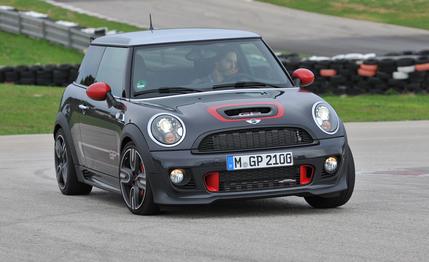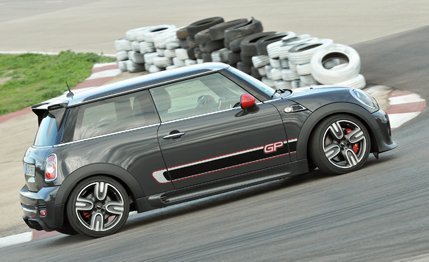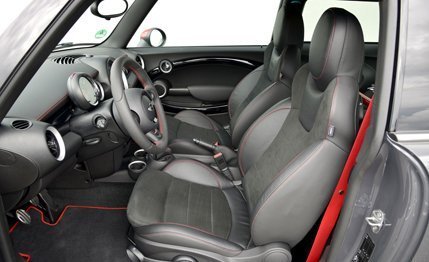 First Drive Review
First Drive Review
“But why?”
According to Mini designer Anders Warming, that’s the question the brain trust in Munich asks repeatedly to justify new ideas. It’s the same one we have after driving one of the brand’s latest ideas, the 2013 Mini John Cooper Works GP.
The $39,950 GP is a limited-edition track-day special that splits the difference between the standard John Cooper Works hardtop and a Mini Challenge race car. Production is capped at 2000 units worldwide, of which we’ll initially get just 500 here in the U.S. Owners of the first-generation, 2006 GP model will have first dibs on the new one, and every buyer can expect to be offered some sort of special perk for their largesse. Although Mini USA has yet to finalize its plans in this regard, think delivery at the Oxford, England, factory. The GP won’t go on sale until March 2013, so there’s ample time to work out the details.
This new version is more precious than the original, a car unironically called “iconic” by Mini suits. (Said personages are quick to remind you that they don’t actually wear suits and even if they did, would certainly not wear ties.) The 2013 GP has a wholly redesigned suspension, with coil-overs offering a 0.8-inch range of adjustment. Compared to the JCW, the GP has been lowered by 0.8 inch in the front and 0.6 inch at the rear. Spring rates have increased by 50 percent with anti-roll bar diameters remaining the same. The front brake hardware includes larger, 13-inch vented front discs and six-piston fixed calipers—non-GP JCWs have four-piston pinchers—while the stock caliper hardware and 11-inch platters carry over out back. A rear wing, diffuser, and underbody panels reportedly reduce lift at the rear axle by 90 percent at speeds above 62 mph. Perhaps most important, GP models get 7.5- by 17-inch aluminum wheels wrapped with aggressive 215/40 Kumho Ecsta V700 tires. With two degrees of negative camber—four times more than the JCW—and reduced toe-in, the GP is set up to make good use of its rubber.

Credit is due to whomever at Mini decided that such a comprehensive overhaul was necessary, given that it could probably move as many units with just a badge and tape job. That said, the GP gets only a three-horsepower bump over the JCW, to 211, with no increase in peak torque (192 lb-ft, or 207 with an overboost function). But while the 2013 GP fails to trump the regular JCW in output, it positively spanks it in its suspension tuning. Mini gave us some 10 laps of a tight, two-mile racetrack in Palma de Mallorca, Spain, to generate impressions and we found the GP to be as fun and easy to drive as you might expect of any Mini.
This one is more neutral, however, with just a whiff of oversteer provided you put the revised dynamic stability control into “GP racing mode,” a laissez-faire setting that is more tolerant of overzealous driving than the standard setting. While the traction control normally would reduce engine power, this doesn’t happen in GP mode, and the front brakes are used to mimic a limited-slip differential.
Like other Minis, the GP has a Sport setting that increases steering effort (without changing the ratio) and sharpens throttle response. We found driving with the Sport mode off actually aided smooth track driving, and that steering feedback wasn’t quite as good as we’d hoped in either setting. But if the latter is a weakness of the GP, its strength lies in how much of what the car is doing gets transmitted through its Recaro seat.

Inside the GP, the two standard front Recaros are the highlight of a red-stitched cabin in which the back seat has been sacrificed in the interest of saving weight. Although Mini didn’t have an exact figure available, representatives did indicate that curb weight could drop by more than 50 pounds compared to the JCW hardtop.
While nominally a street-legal race car, the GP is more of an expensive toy for the biggest fans of the diminutive brand. Not that we’re unenthusiastic about this enthusiast-targeted model—or any new product designed specifically to be fun. It’s just that we’re having a mini challenge of our own with the pricing. If you want a new daily driver that also can go fast on a track, there are any number of options available at this price—with something like a $24,495 Ford Focus ST and a dozen sets of sticky tires representing perhaps the most prudent choice. But there’s no accounting for desire, and those whose predilections run toward Mini’s outsized bravado will no doubt regard the new GP as the second coming it literally is.